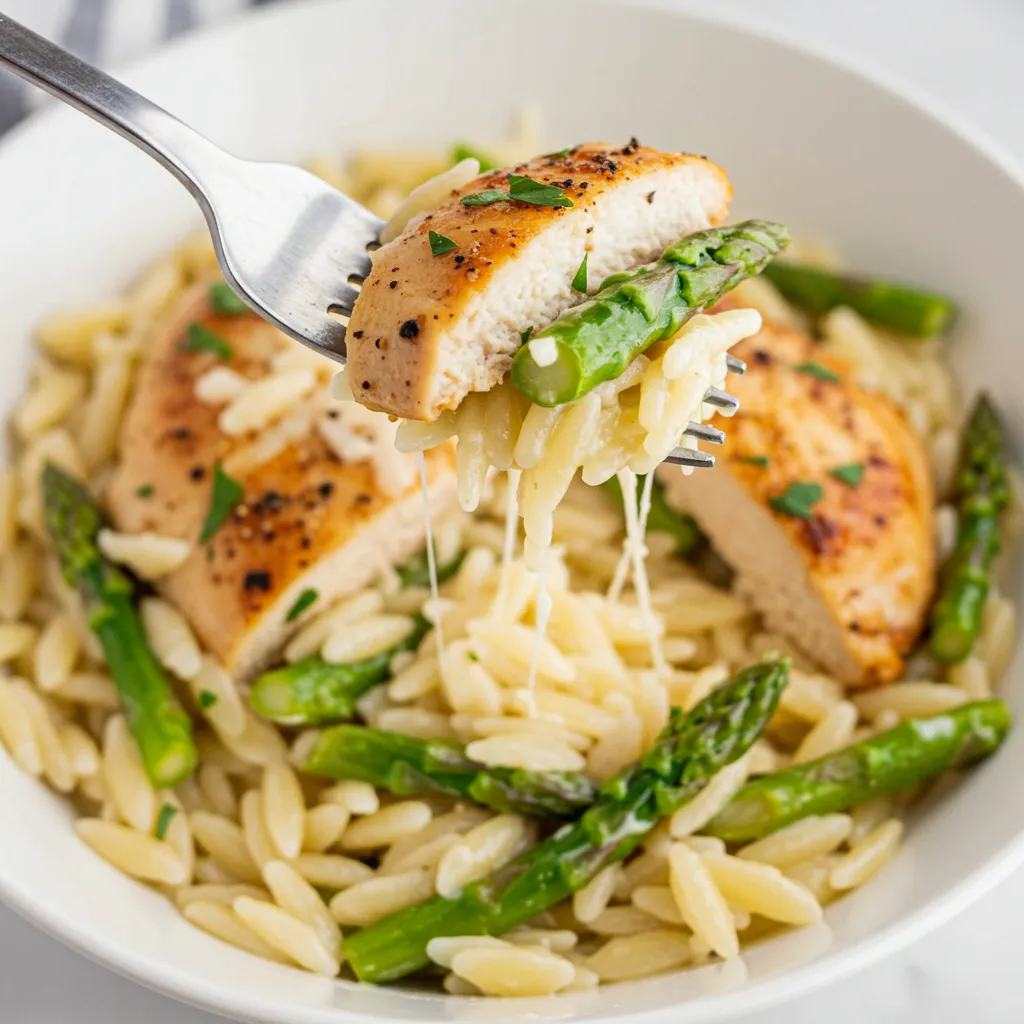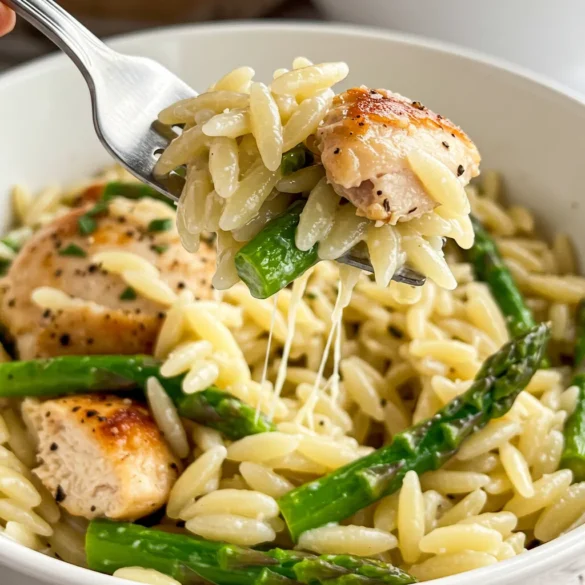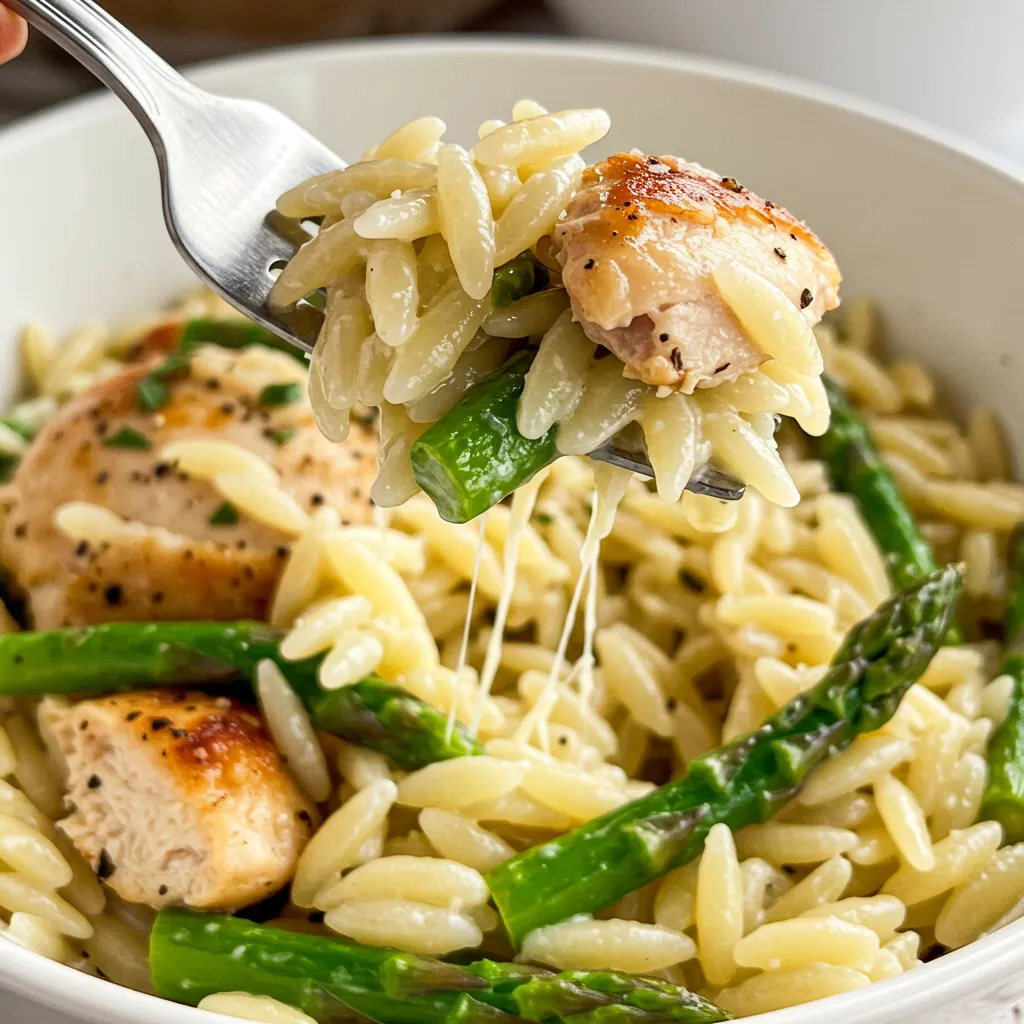This comforting Creamy Parmesan Orzo with Chicken and Asparagus combines tender, pan-seared chicken pieces with al dente orzo pasta in a lusciously rich, Parmesan-infused cream sauce. The chicken pieces, with their golden, seasoned exterior and juicy interior, nestle perfectly among the rice-shaped pasta that’s generously coated in a velvety sauce enhanced with garlic, herbs, and freshly grated cheese. Bright green asparagus spears add color, texture, and nutritional value, creating a beautiful contrast against the creamy background. Each bite delivers a harmonious blend of the orzo’s satisfying texture, the chicken’s savory flavor, and the sauce’s indulgent creaminess. Finished with a sprinkle of fresh herbs that adds a pop of color and brightness, this dish strikes the perfect balance between sophisticated restaurant fare and achievable home cooking—ideal for weeknight dinners, meal prep, or whenever you crave a meal that feels both luxurious and comforting.
Why You’ll Love This Recipe
- One-pot wonder: Most components cook in the same pan for minimal cleanup
- Perfectly balanced: Combines protein, vegetables, and carbohydrates in one satisfying dish
- Versatile ingredients: Can be adapted based on seasonal vegetables and pantry items
- Quick preparation: Ready in about 30 minutes for an impressive weeknight dinner
- Kid-friendly appeal: Creamy texture and familiar flavors appeal to picky eaters
- Meal prep champion: Portions and reheats beautifully for lunches throughout the week
- Visually stunning: Creates an impressive presentation with minimal effort
- Restaurant quality: Achieves a gourmet result using simple techniques and ingredients
- Customizable heat level: Easily adjust seasoning to suit any preference
- Budget-friendly luxury: Creates an elevated dining experience with affordable ingredients
Ingredients
For the Chicken
- Boneless, skinless chicken breasts – The star protein, providing lean meat that cooks quickly and absorbs flavors well
- Kosher salt – Enhances the chicken’s natural flavor and helps create perfect browning
- Black pepper – Adds gentle heat and depth to the chicken’s exterior
- Garlic powder – Infuses the chicken with aromatic flavor without burning like fresh garlic
- Italian seasoning – Provides a blend of herbs that complements both the chicken and pasta
- Olive oil – Facilitates perfect searing and adds fruity notes
- Unsalted butter – Creates a beautiful finish and rich flavor when cooking the chicken
For the Orzo and Cream Sauce
- Orzo pasta – Rice-shaped pasta that creates a risotto-like texture while cooking faster
- Shallots or onion – Forms an aromatic base for the sauce and adds subtle sweetness
- Garlic – Creates an aromatic foundation for the sauce
- Chicken broth – Provides flavorful liquid for cooking the orzo and forms sauce base
- Heavy cream – Gives the sauce its luxurious, velvety texture
- Parmesan cheese – Adds nutty, salty flavor and helps thicken the sauce
- White wine – Deglazes the pan and adds acidity to balance the cream (optional)
- Fresh asparagus – Adds vibrant color, texture, and nutritional value
- Fresh or frozen peas – Provides bursts of sweetness and additional color (optional)
- Lemon juice – Brightens the entire dish with fresh acidity
- Fresh herbs – Add color and freshness (parsley, chives, or basil)
- Red pepper flakes – Provide gentle heat that enhances all flavors (optional)
- Nutmeg – Adds subtle warmth and complexity to the cream sauce (optional)
For Garnish
- Additional grated Parmesan – Adds final flavor boost and appealing presentation
- Fresh herbs – Provide bright color contrast and fresh flavor
- Lemon zest – Brightens the finished dish with citrus aroma
- Cracked black pepper – Adds final seasoning and visual appeal
Step-by-Step Instructions
Preparing the Chicken
Begin by preparing the chicken breasts. Pat 1.5 pounds of boneless, skinless chicken breasts completely dry with paper towels. This crucial step ensures you’ll achieve a beautiful golden sear rather than steaming the chicken.
Cut the chicken into 1-inch cubes or bite-sized pieces for quicker cooking and easier eating. Uniform pieces will ensure even cooking throughout.
In a small bowl, combine 1 teaspoon kosher salt, 1/2 teaspoon freshly ground black pepper, 1/2 teaspoon garlic powder, and 1 teaspoon Italian seasoning. Mix thoroughly to create a seasoning blend that will form a flavorful coating on the chicken.
Season the chicken pieces generously with the spice mixture, tossing to ensure even coverage on all sides. Allow the seasoned chicken to rest for 5-10 minutes to absorb the flavors while you prepare other ingredients.
Heat a large, deep skillet over medium-high heat. Add 1 tablespoon olive oil and 1 tablespoon unsalted butter, allowing the butter to melt and combine with the oil.
Carefully place the seasoned chicken pieces in the hot skillet in a single layer, working in batches if necessary to avoid overcrowding. The chicken should sizzle immediately upon contact with the pan.
Cook the chicken pieces for 2-3 minutes per side until golden brown and nearly cooked through (they’ll finish cooking later in the sauce). The exterior should be golden with some caramelization for maximum flavor.
Transfer the partially cooked chicken to a clean plate and tent loosely with foil to keep warm while preparing the orzo and sauce. The chicken will continue cooking slightly from residual heat.
Preparing the Asparagus
While the chicken is resting, prepare 1 bunch (about 1 pound) of fresh asparagus by trimming the woody ends. The best way to find the natural breaking point is to hold each spear at both ends and gently bend until it snaps naturally.
Cut the trimmed asparagus into 2-inch pieces, keeping the tips intact as they make for an attractive presentation in the final dish.
If using particularly thick asparagus spears, consider halving them lengthwise for more even cooking and easier eating.
Set the prepared asparagus aside while you begin the orzo. It will be added later in the cooking process to maintain its vibrant color and pleasant texture.
Cooking the Orzo and Making the Sauce
Using the same skillet in which you cooked the chicken (without cleaning it), reduce heat to medium and add 1 tablespoon olive oil if the pan seems dry.
Add 1 finely diced shallot or 1/2 cup diced onion to the pan and cook for 2-3 minutes until softened and translucent but not browned.
Add 3 minced garlic cloves and cook for just 30 seconds until fragrant. Be careful not to brown the garlic as it can become bitter.
Optional: Pour in 1/4 cup dry white wine (such as Pinot Grigio or Sauvignon Blanc) to deglaze the pan, using a wooden spoon to scrape up any browned bits from the bottom of the skillet. These contain concentrated flavor that will enhance your sauce. Allow the wine to reduce by half, about 1-2 minutes.
Add 1.5 cups dry orzo pasta to the pan, stirring to coat it in the oil and aromatics. Toast the orzo for about 1 minute, which enhances its nutty flavor and helps it maintain its texture when cooked.
Pour in 3.5 cups chicken broth and bring the mixture to a boil. The liquid should just cover the orzo. Reduce heat to medium-low, cover partially with a lid, and simmer for about 8-10 minutes, stirring occasionally to prevent sticking.
When the orzo is about halfway cooked (after about 5 minutes), add the prepared asparagus pieces to the skillet. This allows the asparagus to cook alongside the orzo without becoming too soft.
If using, add 1/2 cup fresh or frozen peas at the same time as the asparagus. There’s no need to thaw frozen peas first.
Continue cooking until most of the liquid is absorbed and the orzo is al dente (tender but still slightly firm when bitten). The mixture should be creamy but not soupy. If needed, add a splash more broth or water if the orzo becomes too dry before it’s fully cooked.
Reduce heat to low and stir in 1/2 cup heavy cream, allowing it to warm through without boiling, which could cause separation.
Gradually add 1 cup freshly grated Parmesan cheese, stirring continuously until completely melted and incorporated. The sauce should be smooth and coat the orzo nicely.
Add 1 tablespoon fresh lemon juice, a pinch of freshly grated nutmeg (if using), 1/4 teaspoon red pepper flakes (adjust to taste or omit), and salt and pepper to taste. The amount of salt needed will depend on how salty your broth and cheese are.
Finishing the Dish
Return the partially cooked chicken pieces to the skillet, nestling them into the creamy orzo mixture. Include any accumulated juices from the plate for additional flavor.
Allow the chicken to finish cooking in the sauce for about 2-3 minutes until completely cooked through (internal temperature of 165°F) and heated throughout.
Stir in 2 tablespoons chopped fresh herbs (parsley, chives, or basil), reserving some for garnish. The herbs should be added at the last minute to maintain their bright flavor and color.
Remove the skillet from heat and allow the dish to rest for 2-3 minutes, which helps the flavors meld and allows the sauce to thicken slightly.
Taste and adjust seasonings as needed, adding more salt, pepper, lemon juice, or red pepper flakes according to your preference.
Serving
For a beautiful presentation, serve the creamy chicken and orzo directly from the skillet for a rustic, family-style meal, or portion onto warmed plates or shallow bowls.
Garnish generously with additional freshly grated Parmesan cheese, the reserved chopped fresh herbs, a sprinkle of lemon zest, and a final crack of black pepper.
For an extra touch of elegance, add a light drizzle of high-quality olive oil over each serving.
Serve immediately while hot, accompanied by a simple green salad and, if desired, crusty bread for soaking up any remaining sauce.

Pro Tips
- Pound chicken breasts to even thickness before cutting for more consistent cooking
- Toast the orzo before adding liquid for enhanced nutty flavor and better texture
- Use homemade chicken stock if available for superior flavor depth
- Grate Parmesan cheese fresh rather than using pre-grated for superior melting and flavor
- Blanch asparagus separately in salted water for 1-2 minutes if you prefer it more tender
- Reserve some pasta cooking liquid in case the sauce needs thinning later
- Use the side of your chef’s knife to crush whole garlic cloves before mincing for enhanced flavor
- For a thicker sauce, allow it to stand for a few minutes before serving
- Season in layers throughout cooking rather than just at the end for better flavor development
- Choose medium-thick asparagus spears—too thin will overcook, too thick may remain tough
- Add a splash of lemon juice just before serving for the brightest flavor
- Use a microplane for both Parmesan and nutmeg to ensure they incorporate smoothly
- Warm plates before serving to keep the dish hot longer
- For meal prep, slightly undercook the asparagus as it will continue to cook when reheated
- Cut chicken into equal-sized pieces for the most consistent cooking results
- Pat orzo dry after rinsing if you want a less starchy final dish
- Consider reserving the more attractive asparagus tips to add at the very end for presentation
Variations and Creative Ideas
Flavor Variations
Mediterranean Inspired: Add 1/2 cup sun-dried tomatoes, 1/4 cup sliced Kalamata olives, and 1/2 cup crumbled feta cheese instead of (or in addition to) the Parmesan. Finish with fresh oregano and a squeeze of lemon.
Mushroom Lover’s: Replace half the chicken with 8 ounces of sliced mushrooms (cremini, shiitake, or a wild mushroom blend). Sauté the mushrooms until golden before adding the orzo for a deeper, earthier flavor profile.
Lemon Herb: Double the lemon juice and zest, and add 1/4 cup mixed fresh herbs (dill, parsley, chives, and basil) for a bright, herb-forward version perfect for spring and summer.
Spicy Cajun: Season the chicken with Cajun spice blend instead of Italian seasoning, add 1/2 cup diced bell peppers with the onions, and incorporate a dash of hot sauce into the cream sauce.
Protein Alternatives
Shrimp Substitute: Replace chicken with 1 pound of large shrimp, adding them during the last 3-4 minutes of cooking since they cook much more quickly than chicken.
Vegetarian Option: Omit the chicken and double the vegetables, adding 8 ounces of sautéed mushrooms and 1 cup roasted cherry tomatoes for a hearty meatless main course.
Sausage Variation: Substitute the chicken with 1 pound of sliced Italian sausage (sweet or spicy) for a more robust flavor profile that pairs beautifully with the creamy orzo.
Leftover Rotisserie Chicken: Skip the raw chicken preparation and stir in 2 cups of shredded rotisserie chicken at the end, just long enough to warm through for a significant time-saver.
Vegetable Swaps
Seasonal Adaptations: Substitute asparagus with other quick-cooking vegetables depending on the season:
- Spring: Fresh peas, sugar snap peas, or English peas
- Summer: Zucchini, cherry tomatoes, or bell peppers
- Fall: Butternut squash (pre-roasted), Brussels sprouts (thinly sliced), or kale
- Winter: Spinach, Swiss chard, or pre-roasted root vegetables
Broccolini Alternative: Replace asparagus with thinly sliced broccolini for a slightly different flavor and texture while maintaining the visual appeal.
Roasted Vegetable Addition: Incorporate 1 cup of pre-roasted vegetables (bell peppers, zucchini, eggplant) for a deeper, more caramelized flavor profile.
Mediterranean Medley: Use a combination of artichoke hearts, roasted red peppers, and spinach instead of asparagus for a pantry-friendly version available year-round.
Dietary Adaptations
Gluten-Free Version: Substitute orzo with gluten-free orzo or another small gluten-free pasta shape, adjusting cooking time according to package directions.
Dairy-Free Alternative: Replace heavy cream with full-fat coconut milk or cashew cream, and use nutritional yeast instead of Parmesan for a dairy-free version that maintains creaminess.
Lower Carb Option: Reduce orzo to 1 cup and add 2 cups of cauliflower rice during the last 5 minutes of cooking for a higher vegetable content and lower carb count.
Higher Protein Variation: Add 1/2 cup of white beans or chickpeas to boost protein and fiber content without changing the dish’s character significantly.
Storage and Make-Ahead Advice
Complete Dish Storage:
- The fully prepared dish can be refrigerated in an airtight container for up to 3-4 days.
- Store flat rather than stacked for even cooling and to maintain the texture of the components.
- The orzo will continue to absorb liquid during storage, so the dish may thicken considerably.
Reheating Guidelines:
- Reheat gently on the stovetop over medium-low heat, adding a splash of chicken broth or milk to restore creaminess.
- Stir frequently while reheating to prevent sticking and ensure even warming.
- Microwaving is convenient but may result in slightly overcooked chicken; use 70% power and stir halfway through.
- Add a touch of fresh herbs and Parmesan after reheating to refresh flavors.
Make-Ahead Strategy:
- Prepare all components separately up to 2 days ahead: cook chicken, prepare orzo without cream or cheese, and blanch asparagus.
- Store components separately in the refrigerator in airtight containers.
- When ready to serve, combine in a skillet, add cream and cheese, and heat through until warmed and creamy.
- For entertaining, complete the dish up to the point of adding cream and cheese, refrigerate, then finish with dairy products just before serving.
Freezing Guidelines:
- This dish is not ideal for freezing whole due to the cream sauce and the texture of the orzo and asparagus after thawing.
- If you must freeze, do so without the asparagus and add freshly cooked vegetables when reheating.
- Freeze in portion-sized containers for up to 1 month.
- Thaw overnight in the refrigerator before reheating, adding extra liquid as needed to restore creaminess.
Lunchbox Tips:
- Portion into microwave-safe containers for grab-and-go lunches.
- Pack a small container of extra grated Parmesan and fresh herbs to add after reheating.
- Consider slightly undercooking the dish if specifically making it for future lunches.
- Add a splash of water or broth before microwaving at work or school to help revive the creamy texture.
Kid-Friendly Involvement
This approachable dish offers several opportunities for children to participate in the kitchen:
Measuring Ingredients: Kids can help measure orzo, spices, and liquids, practicing math skills while contributing to the meal.
Seasoning the Chicken: Children can mix the dry seasonings and (with supervision) help apply the seasoning to the chicken pieces.
Snapping Asparagus: The natural snapping method for finding where to trim asparagus is fun and safe for children to help with.
Stirring the Orzo: With supervision, older children can help stir the orzo as it cooks, learning about how liquid is absorbed during the cooking process.
Grating Cheese: Kids can help grate Parmesan cheese using a box grater or rotary cheese grater (with appropriate supervision).
Garnishing: Children of all ages can sprinkle the finished dishes with herbs, cheese, and other garnishes, developing pride in the final presentation.
Learning Opportunity: Use this recipe to teach about balanced meals containing protein (chicken), vegetables (asparagus and peas), and carbohydrates (orzo), as well as discussing where different ingredients come from.
Frequently Asked Questions
Can I use other pasta shapes instead of orzo? Yes, though cooking times and liquid amounts may need adjustment. Small pasta shapes like ditalini, acini di pepe, or small shells work best to maintain the dish’s character. Larger shapes like penne or rotini will work but create a different texture and may require more liquid and cooking time.
How do I know when my chicken is perfectly cooked? Perfectly cooked chicken should reach an internal temperature of 165°F. When cut into, it should be opaque throughout with no pink remaining. For this dish, small chicken pieces should cook relatively quickly. If you’re unsure, cut into the largest piece to check – it should be white throughout with clear juices.
Can I make this vegetarian? Absolutely! Omit the chicken and substitute vegetable broth for chicken broth. Add extra vegetables like mushrooms, bell peppers, or zucchini to bulk up the dish. For protein, consider adding white beans, chickpeas, or even cubes of firm tofu sautéed until golden before adding to the finished dish.
My sauce is too thin. How can I thicken it? If your sauce isn’t thickening properly, first try simmering it uncovered for a few more minutes, as orzo continues to absorb liquid. Another option is to add 2-3 additional tablespoons of freshly grated Parmesan, which adds both flavor and thickness. For an immediate fix, make a slurry with 1 teaspoon cornstarch and 1 tablespoon cold water, then stir this into the simmering dish.
Can I use milk instead of heavy cream? While heavy cream produces the richest results, you can substitute half-and-half or whole milk. Be aware that lower-fat dairy may curdle more easily, so add it off the heat and warm gently. For extra richness when using milk, consider adding 2 tablespoons of cream cheese or mascarpone.
What wine pairs best with this dish? This creamy chicken and orzo dish pairs beautifully with medium-bodied white wines with good acidity. Excellent choices include Pinot Grigio, unoaked Chardonnay, Sauvignon Blanc, or Vermentino. The acidity helps cut through the richness of the cream sauce, while complementing the delicate flavors of the chicken and asparagus.

Ingredients
For the Chicken:
- 1.5 pounds boneless, skinless chicken breasts, cut into 1-inch pieces
- 1 teaspoon kosher salt
- 1/2 teaspoon freshly ground black pepper
- 1/2 teaspoon garlic powder
- 1 teaspoon Italian seasoning
- 1 tablespoon olive oil
- 1 tablespoon unsalted butter
For the Orzo and Cream Sauce:
- 1.5 cups dry orzo pasta
- 1 shallot or 1/2 medium onion, finely diced
- 3 garlic cloves, minced
- 1/4 cup dry white wine (optional)
- 3.5 cups chicken broth
- 1 bunch asparagus (about 1 pound), trimmed and cut into 2-inch pieces
- 1/2 cup fresh or frozen peas (optional)
- 1/2 cup heavy cream
- 1 cup freshly grated Parmesan cheese
- 1 tablespoon fresh lemon juice
- Pinch of freshly grated nutmeg (optional)
- 1/4 teaspoon red pepper flakes (optional)
- Salt and pepper to taste
- 2 tablespoons fresh herbs (parsley, chives, or basil), chopped
For Garnish:
- Additional grated Parmesan cheese
- Fresh herbs, chopped
- Lemon zest
- Freshly cracked black pepper
Instructions
- Season diced chicken with salt, pepper, garlic powder, and Italian seasoning.
- Sear chicken in olive oil and butter until golden brown; set aside.
- In the same pan, sauté shallot and garlic until fragrant.
- Add orzo, toast briefly, then add chicken broth and bring to a simmer.
- Cook orzo for about 5 minutes, then add asparagus and optional peas.
- Continue cooking until orzo is tender and liquid is mostly absorbed.
- Stir in heavy cream and Parmesan cheese until melted and creamy.
- Return chicken to the pan to finish cooking and warm through.
- Add lemon juice, herbs, and adjust seasonings to taste.
- Serve garnished with additional Parmesan, herbs, lemon zest, and black pepper.
Notes
- Use chicken thighs instead of breasts for juicier, more forgiving results
- Warm the cream slightly before adding to reduce the risk of curdling
- Keep extra broth on hand to adjust consistency as needed
- For easier cleanup, use a non-stick or well-seasoned cast iron skillet
- Choose asparagus spears of similar thickness for even cooking
- Toast the orzo until lightly golden for a nuttier flavor and better texture
- Grate cheese just before using for freshest flavor and best melting
- Don't rush the orzo cooking process—the slow absorption creates creaminess
- Season in stages throughout cooking rather than all at once at the end
- If making ahead, slightly undercook both pasta and vegetables
- For added flavor, use the zest of the lemon before juicing it
- Allow the dish to rest for a few minutes before serving to thicken
- Store leftovers in shallow containers for quicker cooling and safer food storage
- When reheating, add a splash of liquid to revive the creamy texture
- For a special touch, finish with a drizzle of extra virgin olive oil
- Choose a skillet with tall sides to prevent spillover when stirring
- Cut vegetables on the diagonal for a more elegant presentation
- Reserve some asparagus tips for garnish and visual appeal
- Consider using a combination of Parmesan and Romano cheeses for more complex flavor
- For meal prep, store in individual portions for grab-and-go convenience

